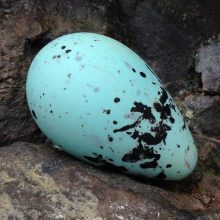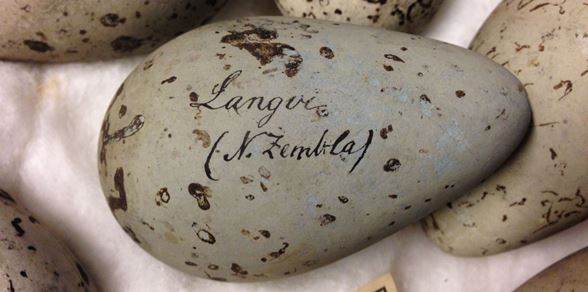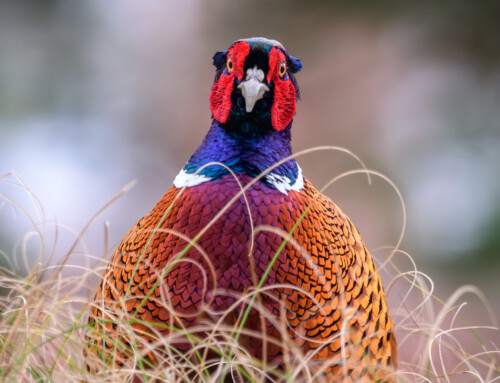Why did the Common Guillemot’s egg evolve its pear-like shape?
LINKED PAPER
The point of a Guillemot’s egg. Birkhead, T.R., Thompson, J.E., Jackson, D. & Biggins, J.D. 2017. IBIS. DOI: 10.1111/ibi.12458. VIEW
Many years ago in 1992 when I was conducting fieldwork on Common Guillemots Uria aalge on a group of islands off the coast of Labrador, Canada. I came a cross a sight that I shall never forget. After the winter ice retreated, a family of Arctic Foxes Vulpes lagopus had been stranded on the islands, and was causing mayhem amongst the seabirds. One day I came across an area that had previously held several hundred pairs of Guillemots, only to find their eggs — dozens and dozens of them —scattered, broken and piled up in gullies at the edge of the colony. I have studied Guillemots since 1972 and never before or afterwards have I seen such devastation.
This shouldn’t have happened. Not least because deeply embedded in the brain of almost everyone that has ever thought about it, is the firm belief that the Guillemot’s peculiar, pear-shaped egg shape, is an adaptation to minimize the risk of it rolling or falling off the bare rock ledge on which they are laid. It didn’t seem to work very well on that occasion and I began to wonder what the evidence was that the pointed egg — technically, pyriform, or pear shaped — had evolved to safeguard the Guillemot’s egg.

The story starts in Russian arctic in the 1930s and 1940s, when it was decided to harvest Guillemot eggs on a massive scale at some of their huge colonies. The focus was on maximising the numbers of eggs taken and to this end a team of biologists was employed ostensibly to determine how sustainable this was. It was important to identify the causes of egg loss and measure normal breeding success. This was new; no one had measured breeding success of Guillemots before and the researchers made repeated visits onto the breeding ledges, flushing the birds each time, and like the Arctic Foxes in my study, causing a huge loss of eggs through rolling. The conclusion was that rolling was a major factor in egg mortality – not realising that this was largely due to the researchers themselves.
The Russian researchers also suggested that the guillemot’s pyriform egg had evolved to minimize the risk of falling — as a result of its shape— by rolling in an arc.
Prior to this the Guillemot’s egg was said to spin like a top when knocked, and remain in the same place. Not true – as the Russian biologists knew. Instead, they grasped at the rolling-in-an-arc idea, and indeed on a gently sloping, but even surface a guillemot’s egg does indeed roll in an arc. In contrast, a more typically egg-shaped egg, like that of a Razorbill Alca torda, either rolls away or in a much wider arc.

Subsequent researchers, working in Norway in the 1950s, ‘60s and 70s, explored this further, rolling real Guillemot and Razorbill eggs on real ledges. But under these more realistic conditions, they found no real evidence that the guillemot’s pointed egg had any advantage in keeping it from rolling and falling.
That work was published in German, with only and English summary, but the original story remained unchanged. The idea that the Guillemot’s pointed egg has evolved to safeguard it from rolling and falling has deep intuitive appeal. Ask anyone – they pretty much all say the same thing.
It was after hearing someone proffer the spinning-like-a-top idea, that I realised that I should re-visit this problem. So my colleagues Jamie Thompson, Duncan Jackson and John Biggins and I decided to investigate. I was very familiar with Guillemots and could think of several other explanations for a pyriform-shaped egg.
The way to think about this was to identify other selection pressures that could be shaping Guillemot eggs. To do this you need to know how Guillemots breed; you need to have got down and dirty with Guillemots on their breeding ledges to know what it is like. Guillemots breed at very high densities, around twenty pairs, packed together per square metre. They do this to better defend their eggs and chicks from predatory gulls. The downside of this is that Guillemot colonies are busy places; birds fight; birds alight on top of each other and all this bustle means that eggs might become damaged while they are being incubated. Guillemot breeding colonies are also dirty places; Guillemots defecate without regard for anyone, and in wet weather particularly, Guillemot ledges can be like a pigsty, and eggs contaminated by ‘muck’ (to put it politely).

© Tim R. Birkhead
Two selection pressures on eggs then, not previously considered: risk of breakage while being incubated, and contamination with muck. Contamination with muck might block pores and disrupt the flow of gases in and out of the shell, compromising the developing embryo inside the egg.

Our paper in IBIS discusses the likelihood on these two factors either alone or together, being responsible for the Guillemot’s pyriform egg. First, a pyriform shape, together with a thick eggshell, may minimize the risk of damage to the egg via an impact. Second, the pyriform shape means that the pointed end of the egg tends to lie along the ledge, with the blunt end sticking upwards clear of the muck. When we checked, Guillemot eggs were much more likely to be contaminated than Razorbill eggs, but the blunt end of the egg was often clean.

There may be other factors favouring a pear-shaped egg among Guillemots, and our research is continuing. One thing seems to be clear though: the rolling-in-an-arc story has very little going for it.
Reference
Birkhead, T.R., Thompson, J.E., Jackson, D. & Biggins, J.D. 2017. The point of a Guillemot’s egg. IBIS 159: 255–265. VIEW
Birkhead, T.R., Thompson, J.E. & Biggins, J.D. 2017. Egg shape in the Common Guillemot Uria aalge and Brunnich’s Guillemot U. lomvia: not a rolling matter? Journal of Ornithology. DOI: 10.1007/s10336-017-1437-8. VIEW
Image credit
Featured image: Common Guillemot Uria aalge pyriform (pear-shaped) egg © Tim R. Birkhead
If you want to write about your research in #theBOUblog, then please see here.






